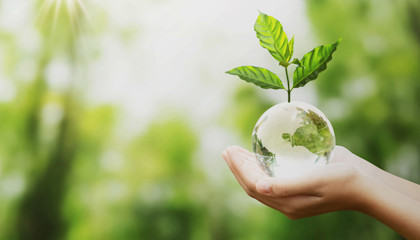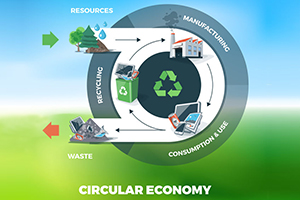Sustainable business comes full circle

As businesses and society seek to mitigate environmental impact and curb climate change, one approach that is quickly gaining momentum is the circular economy model.
Many of the environmental issues currently faced by our planet are linked to a learned human behavior that treats almost everything we buy and own as disposable. As populations, industrialization and urbanization increase around the world, the amount of waste we generate each year continues to rise. But what if this didn’t have to be the case?
A circular economy, according to the Ellen MacArthur Foundation, is one that is “restorative and regenerative by design” and “based on the principles of designing out waste and pollution, keeping products and materials in use and regenerating natural systems.”

The Ellen MacArthur Foundation is a charity that aims to inspire a generation to rethink, redesign and build a positive future through the framework of a circular economy. Similarly, Green Alliance is a UK-based nonprofit and independent think tank that focuses on ambitious leadership for the environment and works with influential leaders from the NGOs, business and political communities. The two groups seek to bring about a fundamental paradigm shift, believing it is possible to change the way companies, consumers and governments view waste and consumerism.
“At Green Alliance, we see the circular economy as one that invests less energy and material in new products and gets more value out of these products once they’ve been produced,” says Dustin Benton, Green Alliance Policy Director. “The best way of doing this is to keep products in use for as long as possible.”
Circular economy models offer a new route to decarbonizing heavy industry
Benton argues that the practice of reusing products instead of disposing of them would create tangible benefits, both for the environment and for business.
“Take a cell phone, for instance,” he says. “As it is manufactured using carbon-intensive processes and rare materials, keeping it in use for just one extra year would reduce the carbon footprint of its use by around a third.” Cellphone reuse companies are becoming more and more common, he says, “because they see that it’s profitable to collect and resell mobile phones for up to five or so years, even though so many customers switch after just two.”
“Circular economy models offer a new route to decarbonizing heavy industry,” says Benton. “Take buildings as an example. Most are constructed using carbon-intensive materials such as concrete and steel. But reuse the steel and replace the concrete with cross-laminated timber, and the result is a building with 80 percent lower whole-life carbon emissions.”
Meanwhile, the cost of development would be roughly equivalent to that of a conventional, high-carbon building, he says. “Buildings such as these have been constructed in the UK,” he explains, “so this example isn’t just a sustainable pipe dream – it’s actually a reality.”
For companies trying to pursue a circular economy approach, Green Alliance regards the main hindrance at present as a lack of supportive government policy.
“With the building case, for example, we believe governments should simply mandate reductions in whole-life carbon emissions – especially given that there is no cost premium involved,” Benton says. “This would provide a major impetus for circular design.”
The electronics segment is another example highlighted by Green Alliance. The Alliance maintains that we need regulations that reward reuse, such as smarter producer responsibility rules. The introduction of this kind of legislation would not only encourage consumers to keep their phones for longer, but it would also put pressure on manufacturers not to design products intended to become obsolete after only a couple of years.
“This would not only be cheaper and better for the environment,” Benton says, “but it would also force a rethink of the current waste electronics rules, which reward taking a used phone worth approximately 350 euros and smashing it to recover roughly one euro’s worth of gold inside it.”
However, not all policymaking is missing the mark when it comes to circularity. In 2016–2017, the European Union decided to implement new “eco-design rules,” which will apply from 2020, requiring products to be designed from the outset to last longer, as well as giving the consumers the right to repair them. This legislation is linked to studies carried out by Green Alliance in 2015 and 2016, which demonstrated that circular economy policy could create more than a million new jobs across Germany, Italy, Poland and the UK by 2030, of which some 330,000 would be taken by people who are currently unemployed. Dustin Benton, Green Alliance Policy Director
Dustin Benton, Green Alliance Policy Director
“This is a major step in the right direction, but we'll need to see more of this type of policy leadership if the huge benefits of the circular economy are to be realized,” Benton says.
According to the Ellen MacArthur Foundation, the circular economy has the potential to deliver enormous benefits on a global scale, including a 48 percent reduction in carbon emissions by 2030 and material cost savings amounting to 700 million U.S. dollars per year in the fast-moving consumer goods segment. This could be achieved by designing out waste and pollution, keeping products and materials in use and regenerating natural systems.
Circularity is nothing new for the Sandvik Machining Solutions (SMS). Lars Ederström, Project Lead Sustainability and Governance with SMS, explains that the circular economy business model and a buy-back program for used products has been in play here since the late 1990s.
“In 2006, Sandvik Coromant launched a more focused customer buy-back program shared between sales and supply, through which customers could return their used products so we can recycle them and reclaim key materials such as tungsten and other rare and precious metals,” Ederström explains.
After a couple of years, the program started to increase in volume. Today it is a well-functioning process that adds significant value to SMS’s customers and its operations.
Implementing a circular economy is vital in order to ensure that we make the most of all the resources we have available
“Our customers appreciate that we manage this end-of-life process for them,” Ederström says. “We have processes in place to come and collect them. In addition, they know that they are contributing to a circular system, in which their products are ultimately recycled and reused to produce new products. SMS has facilities to take care of used products, utilizing chemical and mechanical processes to ensure that the materials can be reused. So together we are making each other more sustainable.”
Sandvik Mining and Rock Technology case study
At Sandvik Mining and Rock Technology, recycling drill bits containing steel and cemented carbide has reduced energy consumption by around 75 percent compared with using virgin materials. This in turn has led to a 40 percent reduction of CO2 emissions and a significant reduction in NOx emissions, while the use of hazardous chemicals has been virtually eliminated.
Going forward, SMS will continue to seek opportunities to further increase the use of secondary materials instead of virgin materials. SMS will also place stricter demands on its suppliers of raw materials and packaging, requiring them to increase their use of secondary and recycled materials, thus ensuring not only that it recycles its own products but that the materials it buys will also be recyclable and based increasingly on used materials.
At Sandvik Mining and Rock Technology, Marie Brodin, Vice President Sustainable Business and Communications, explains that the recycling of used goods and material is an established part of the business model and that a variety of initiatives have been launched to support the Sandvik Group’s target of 90 percent circularity by 2030. For example, the organization recognizes the need to recycle steel and cemented carbide and has a comprehensive recycling program that benefits customers as well as the company.
“Implementing a circular economy is vital in order to ensure that we make the most of all the resources we have available,” she says. “We operate in a highly competitive market, and every percentage in improved productivity supports our business objectives to become and stay a market leader in all our areas. The more we maximize the productivity of the materials we use as part of a circular business model, the more sustainable – and competitive – we will become. For us, sustainability and business success go hand in hand.”
Sandvik Group circular economy objectives
It is the stated objective of the Sandvik Group to achieve more than 90 percent circularity by 2030. This will be achieved through:
- Material and resource improvements as part of all development projects
- The development of business models for recycling and circularity for customers
- 90 percent material circularity in all products, including packaging materials
- 50 percent reduction in waste in production processes
- 90 percent circularity requirement for key suppliers.